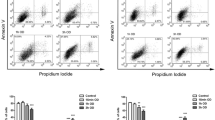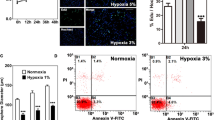Abstract
Nervous system cells are highly dependent on adequate tissue oxygenation and are very susceptible to hypoxia, which causes mitochondrial dysfunctions involved in apoptosis and necrosis. In this paper, we examine the effect of a 12-h incubation of differentiated IMR-32 neuroblastoma cells in a hypoxic environment (73% N2: 2% O2: 5% CO2, v:v) by evaluating cell viability, modifications of NO, intracellular Ca2+ concentration [Ca2+]i and membrane potential, the production of phosphorylated ERK, desferoxamine-chelatable free iron and esterified F2-isoprostane levels. The same parameters were evaluated after a subsequent 24-h re-oxygenation period. The NO concentration increased significantly immediately after hypoxia and returned to values similar to those of controls after the reoxygenation period. At the same time, we observed a significant increase of [Ca2+]i immediately after hypoxia. Phosphorylated ERK proteins increased significantly during the first 2 h of hypoxia, then decreased, and remained practically unmodified after 12 h hypoxia and the following reoxygenation period. Moreover, IMR-32 cell mitochondria were significantly depolarized after hypoxia, while membrane potential returned to normal after the reoxygenation period. Finally, desferoxamine-chelatable free iron and F2-isoprostane levels also increased significantly after hypoxia. Our results indicate that 2% O2 hypoxia induces variations of NO and [Ca2+]i with subsequent mitochondrial depolarization, and it is responsible for oxidative stress, represented by increased free iron and F2-isoprostane, protein carbonyls and 4 hydroxynonenal protein adducts levels.











Similar content being viewed by others
References
Banasiak KJ, Xia Y, Haddad GG (2000) Mechanisms underlying hypoxia-induced neuronal apoptosis. Prog Neurobiol 62:215–249
Green DR, Kroemer G (2004) The pathophysiology of mitochondrial cell death. Science 305:626–629
Kroemer G, Reed JC (2000) Mitochondrial control of cell death. Nat Med 6:513–519
Desagher S, Martinou JC (2000) Mitochondria as the central control point of apoptosis. Trends Cell Biol 10:369–377
Mottet D, Michel G, Renard P, Ninane N, Raes M, Michiels C (2002) Role of ERK and calcium in the hypoxia-induced activation of HIF-1. J Cell Physiol 194:30–44
Bano D, Nicotera P (2007) Ca2 + signals and neuronal death in brain ischemia. Stroke 38:674–676
Tanaka K, Iijima T, Mishima T, Suga K, Akagawa K, Iwao Y (2009) Ca(2+) buffering capacity of mitochondria after oxygen-glucose deprivation in hippocampal neurons. Neurochem Res 34:221–226
Rego AC, Oliveira CR (2003) Mitochondrial dysfunction and reactive oxygen species in excitotoxicity and apoptosis: implications for the pathogenesis of neurodegenerative diseases. Neurochem Res 28:1563–1574
Kress GJ, Dineley KE, Reynolds IJ (2002) The relationship between intracellular free iron and cell injury in cultured neurons, astrocytes, and oligodendrocytes. J Neurosci 22:5848–5855
Lipscomb DC, Gorman LG, Traystman RJ, Hurn PD (1998) Low molecular weight iron in cerebral ischemic acidosis in vivo. Stroke 29:487–492
Aldinucci C, Carretta A, Ciccoli L, Leoncini S, Signorini C, Buonocore G, Pessina GP (2007) Hypoxia affects the physiological behavior of rat cortical synaptosomes. Free Radic Biol Med 42:1749–1756
De Felice C, Ciccoli L, Leoncini S, Signorini C, Rossi M, Vannuccini L, Guazzi G, Latini G, Comporti M, Valacchi G, Hayek J (2009) Systemic oxidative stress in classic Rett syndrome. Free Radic Biol Med 47:440–448
Blanco GJ, Aldinucci C, Maiorca SM, Palmi M, Valoti M, Buonocore G, Pessina GP (2009) Physiopathological effects of the NO donor 3-morpholinosydnonimine on rat cortical synaptosomes. Neurochem Res 34:931–941
Aldinucci C, Carretta A, Pessina GP (2005) The effect of mild and severe hypoxia on rat cortical synaptosomes. Neurochem Res 30:981–987
Perez-Pinzon MA, Sick TJ, Rosenthal M (1999) Mechanism(s) of mitochondrial hyperoxidation after global cerebral ischemia. Adv Exp Med Biol 471:175–180
Tumilocwicz JJ, Nichols WW, Cholon JJ, Greene AE (1970) Definition of a continuous human cell line derived from neuroblastoma. Cancer Res 30:2110–2118
Rao RR, Kisaalita WS (2002) Biochemical and electrophysiological differentiation profile of a human neuroblastoma (IMR-32) cell line. In Vitro Cell Dev Biol Anim 38:450–456
Hesketh TR, Smith GA, Moore JP, Taylor MV, Metcalfe JC (1983) Free cytoplasmic calcium concentration and the mitogenic stimulation of lymphocytes. J Biol Chem 258:4876–4882
Tsien RY, Pozzan T, Rink TJ (1982) Calcium homeostasis in intact lymphocytes: cytoplasmic free calcium monitored with a new, intracellularly trapped fluorescent indicator. J Cell Biol 94:325–334
Grynkiewicz G, Poenie M, Tsien RY (1985) A new generation of Ca2 + indicators with greatly improved fluorescence properties. J Biol Chem 260:3440–3450
Comporti M, Signorini C, Leoncini S, Buonocore G, Rossi V, Ciccoli L (2004) Plasma F2-isoprostanes are elevated in newborns and inversely correlated to gestational age. Free Radic Biol Med 37:724–732
Lim Y, Phung AD, Corbacho AM, Aung HH, Maioli E, Reznick AZ, Cross CE, Davis PA, Valacchi G (2006) Modulation of cutaneous wound healing by ozone: differences between young and aged mice. Toxicol Lett 160:127–134
Porwol T, Ehleben W, Brand V, Acker H (2001) Tissue oxygen sensor function of NADPH oxidase isoforms, an unusual cytochrome aa3 and reactive oxygen species. Respir Physiol 128:331–348
Wilensky EM, Bloom S, Leichter D, Verdiramo AM, Ledwith M, Stiefel M, LeRoux P, Grady MS (2005) Brain tissue oxygen practice guidelines using the LICOX CMP monitoring system. J Neurosci Nurs 37:278–288
Mummery CL, van den Brink CE, van der Saag PT, de Laat SW (1984) A short-term screening test for teratogens using differentiating neuroblastoma cells in vitro. Teratology 29:271–279
Aldinucci C, Maiorca SM, De Rosa P, Palmi M, Sticozzi C, Ciccoli L, Leoncini S, Signorini C, Pessina GP (2010) The effects of hypoxia/reoxygenation on the physiological behaviour of U373-Mg Astrocytes. Neurochem Res 35:42–49
Iadecola C (1997) Bright and dark sides of nitric oxide in ischemic brain injury. Trends Neurosci 20:132–139
Kawahara K, Yanoma J, Tanaka M, Nakajima T, Kosugi T (2004) Nitric oxide produced during ischemia is toxic but crucial to preconditioning-induced ischemic tolerance of neurons in culture. Neurochem Res 29:797–804
Lemasters JJ, Holmuhamedov E (2006) Voltage-dependent anion channel (VDAC) as mitochondrial governator—thinking outside the box. Biochim Biophys Acta 1762:181–190
Millar TM, Phan V, Tibbles LA (2007) ROS generation in endothelial hypoxia and reoxygenation stimulates MAP kinase signaling and kinase-dependent neutrophil recruitment. Free Radic Biol Med 42:1165–1177
Gaasch JA, Lockman PR, Geldenhuys WJ, Allen DD, Van der Schyf CJ (2007) Brain iron toxicity: differential responses of astrocytes, neurons, and endothelial cells. Neurochem Res 32:1196–1208
Breuer W, Greenberg E, Cabantchik ZI (1997) Newly delivered transferrin iron and oxidative cell injury. FEBS Lett 403:213–219
Tanaka E, Niiyama S, Sato S, Yamada A, Higashi H (2003) Arachidonic acid metabolites contribute to the irreversible depolarization induced by in vitro ischemia. J Neurophysiol 90:3213–3223
Fisk L, Nalivaeva NN, Boyle JP, Peers CS, Turner AJ (2007) Effects of hypoxia and oxidative stress on expression of neprilysin in human neuroblastoma cells and rat cortical neurones and astrocytes. Neurochem Res 32:1741–1748
Acknowledgments
Work supported in part by MIUR, PRIN 2005 PROT.2005 06 9071-005 and in part by PAR servizi.
Author information
Authors and Affiliations
Corresponding author
Rights and permissions
About this article
Cite this article
Aldinucci, C., Maiorca, S.M., De Rosa, P. et al. The Physiological Behaviour of IMR-32 Neuroblastoma Cells is Affected by a 12-h Hypoxia/24-h Reoxygenation Period. Neurochem Res 35, 1691–1699 (2010). https://doi.org/10.1007/s11064-010-0231-2
Accepted:
Published:
Issue Date:
DOI: https://doi.org/10.1007/s11064-010-0231-2




